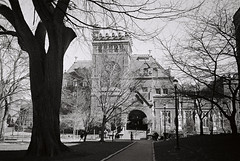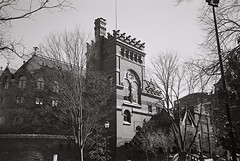Tube Tuesday: Fightin’ Phils
In honor of the 2010 Phillies’ fourth straight NL East title, scenes from the late great Shibe Park. Later coined Connie Mack Stadium, it was the first concrete and steel stadium in the majors, designed in 1909 by Philadelphia architects William Steele & Sons. The fifty-foot outfield wall was erected 1935 to block views from rowhouse roofs across the street (the “cable blackout” of its day). Abandoned in 1970 and arson-ravaged in 1971, the park was demolished in 1976.
Endangered Properties
 CLICK HERE to nominate an at-risk building in or around Philadelphia to the Preservation Alliance’s annual Endangered Properties List. To see past lists, CLICK HERE.
CLICK HERE to nominate an at-risk building in or around Philadelphia to the Preservation Alliance’s annual Endangered Properties List. To see past lists, CLICK HERE.
Tomorrow’s Landmarks Today
Two things are true about architectural taste:
1) Almost every new style and new generation of buildings will eventually be loathed as out-of-date and ugly.
2) Almost every “out-of-date and ugly” style of building will eventually be appreciated as historic and beautiful.
It was true for Colonial buildings, for Federal buildings, for Victorian buildings, for Beaux-Arts buildings, for Art Deco buildings, and it is true for mid-century modern buildings, too (not to mention post-modern and post-post-modern buildings, but let’s not get ahead of ourselves). The process is gradual and almost alchemical– buildings viewed as interlopers and unwelcome guests one day are eventually forgiven. Styles seen as arbitrary, cheap or false yesterday will assume the gravitas of history tomorrow. It’s like clockwork, but it’s also like watching a pot of water trying to boil. You can never see it until it happens.
Like it or not, it is happening right now for mid-century architecture in Philadelphia. But obviously, not all buildings from this era are equally interesting, significant, or valuable. So the Preservation Alliance created a ballot of Philadelphia buildings, both well-known and overlooked, built between 1945 and 1980. We want you to vote for your favorites. We want you to tell us what we left off (obviously a lot). We even want to know what you’d like to see demolished. You can vote once a day in each category, so vote early and vote often.
The polls are now open for the first five categories, and five more will be released in the coming weeks. Happy voting!
Tube Tuesday: Architectural Wallflowers
In this gem of an interview produced by Temple University, photographer Betsy Manning and professor Ken Finkel (whose Redbricker column for Philly Brownstoner never ceases to amaze/amuse) discuss Manning’s passion for documenting the lesser-known corners of the city. She describes her subjects as “architectural wallflowers”– overlooked, ignored, nondescript, until you stop and really see them. The Preservation Alliance is excited to host Manning as she presents more of her work on Wednesday, October 27 at 6:30 pm at the Northeast Regional Free Library (2228 Cottman Avenue). Free and open to the public, registration is encouraged by emailing ben@preservationalliance.com or calling 215-546-1146 x5.
And a teaser– expect more of Manning’s finds to turn up on Field Notes in the near future….
Six Degrees of Edmund Bacon
Edmund Bacon, Executive Director of the Philadelphia Planning Commission from 1949 to 1970, is often called the father of modern Philadelphia. His hand guided virtually every major postwar project in the city. He was also the father of actor Kevin Bacon, whose six degrees of separation from every actor known to man is the stuff of dorm room and cocktail party legend. Like father like son, what better way to meander the byways of Philadelphia (and world) history than via The Six Degrees of Edmund Bacon?
The Game: Name a famous Philadelphian. Connect him or her to Edmund Bacon in six steps, using common sites, buildings, events, or relationships.
The Challenge: Chubby Checker.
View one solution after the jump (click “read rest of this page” below). Are there any others?






